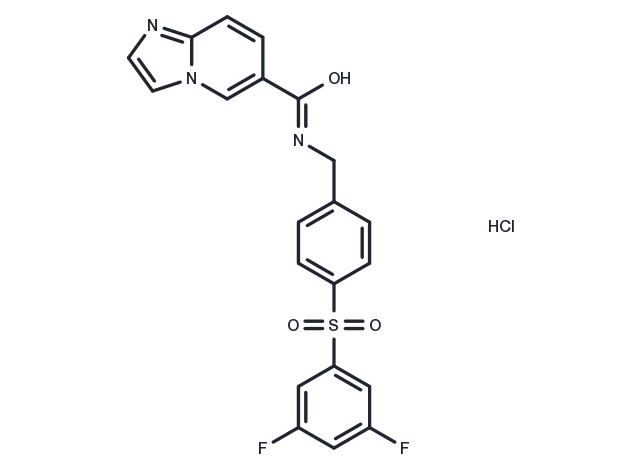Powder: -20°C for 3 years | In solvent: -80°C for 1 year


GNE-617 hydrochloride is a potent and competitive inhibitor of nicotinamide phosphoribosyltransferase (IC50: 5nM). GNE-617 hydrochloride reduces the NAD levels in a < 95% reduction in both NAPRT1-deficient and NAPRT1-proficient cell lines and exerts (EC50: 0.54nM to 4.69nM).

| Pack Size | Availability | Price/USD | Quantity |
|---|---|---|---|
| 2 mg | Inquiry | $ 160.00 | |
| 5 mg | Inquiry | $ 237.00 | |
| 10 mg | Inquiry | $ 371.00 | |
| 50 mg | Inquiry | $ 938.00 |
| Description | GNE-617 hydrochloride is a potent and competitive inhibitor of nicotinamide phosphoribosyltransferase (IC50: 5nM). GNE-617 hydrochloride reduces the NAD levels in a > 95% reduction in both NAPRT1-deficient and NAPRT1-proficient cell lines and exerts (EC50: 0.54nM to 4.69nM). |
| In vitro | In the in-vitro ADME assessments, GNE-617 hydrochloride shows the most optimal combination of in vitro metabolic stability, MDCK permeability, and protein binding. Besides that, GNE-617 hydrochloride has potent antiproliferation effects on various cell lines. The IC50 values of it in U251, HT1080, PC3, MiaPaCa2 and HCT116 cell lines are 1.8nM, 2.1nM, 2.7nM, 7.4nM and 2nM, respectively. |
| In vivo | GNE-617 hydrochloride also shows significant antitumor effects on U251 human glioblastoma tumor xenografts in mice and has no obvious effect on body weight loss [1][2]. |
| Synonyms | GNE-617 hydrochloride |
| Molecular Weight | 463.88 |
| Formula | C21H16ClF2N3O3S |
| CAS No. | T22801 |
Powder: -20°C for 3 years | In solvent: -80°C for 1 year
DMSO: Soluble
You can also refer to dose conversion for different animals. More
bottom
Please see Inhibitor Handling Instructions for more frequently ask questions. Topics include: how to prepare stock solutions, how to store products, and cautions on cell-based assays & animal experiments, etc.
GNE-617 hydrochloride (1362154-70-8 free base) T22801 Others GNE617 hydrochloride (1362154708 free base) GNE617 Hydrochloride GNE 617 Hydrochloride 1362154-70-8 GNE 617 hydrochloride (1362154 70 8 free base) GNE-617 hydrochloride 1362154-70-8 free base GNE-617 Hydrochloride inhibitor inhibit
